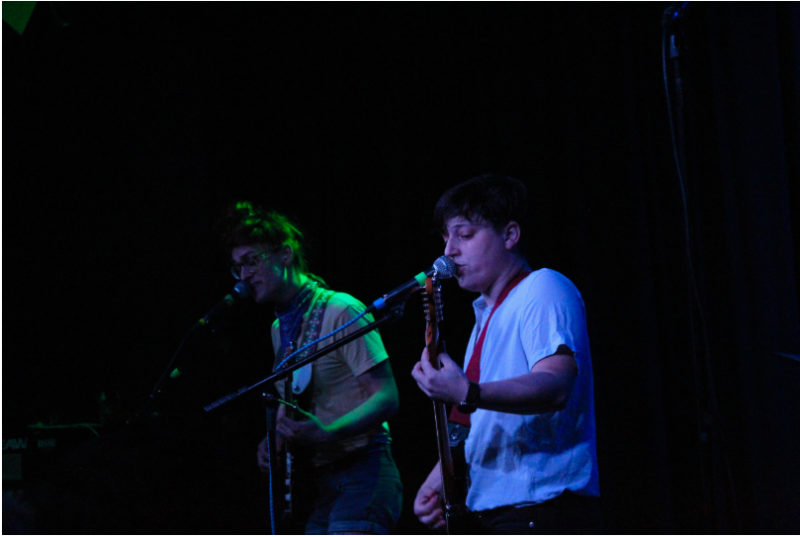Turning Up the Volume with Mal Blum
Review of Mal Blum at the Vera Project.
Written by Teen Editor Tova Gaster and edited by Teen Editor Anya Shukla.

During their all-ages show at the Vera Project on August 22, musician Mal Blum declared that they weren’t getting into any fights on social media for the month. As they wrote on Twitter earlier that day, they instead opted to “focus on [their] all ages show in Seattle and the trans kids [they] get to meet every night IRL instead. No more tweet beef!!”
At Blum’s energetic and vulnerable show, the crowd was indeed full of trans kids, and Blum’s driving pop-punk guitar and shouted lyrics energized the audience. Blum’s stage presence is self-deprecating and charismatic, and their boyish low voice slides seamlessly into a clear upper register. They’re short with a confident center of gravity.
Guitar in hand, Blum played straight through their 2019 release Pity Boy. The album deals with processing hardship and mental illness as a queer person (Blum identifies as trans and nonbinary). They explore the tension of directing anger inward as self-hatred, or outward via fights on Twitter—struggling to be heard by those who don’t want to hear them.
Pity Boy is described on their website as “an album that examines the patterns that recur over the course of our lives and what happens when we try (and often fail) to break them.” Blum processes the impacts of transphobia and mental illness on themself and on their dynamics with loved ones—patterns which reveal themselves in different ways through the nonlinear flow of the album.
A repeated theme is Blum’s struggle with toxic relationship dynamics. Due to societal oppression and violence, the LGBTQ community experiences disproportionately high rates of mental illness and substance abuse. Blum poses the question: how do we form healthy and mutually supportive relationships when both parties are struggling with mental health or trauma? In their song “Not My Job,” Blum loudly sings over driving guitars, “It’s not my job to make you well,” as if to drown out their own misgivings. “If I have to, I’ll kill off my better self...Because you gotta protect yourself.”
They assert a hard truth: you can’t be someone’s only lifeline to stability and happiness, and you can’t depend on them to be yours, no matter how much you care about each other. It’s hard to think that sometimes we can’t heal each other from the harm and trauma society often inflicts on queer and trans people, especially when that intersects with other forms of oppression.
The flipside is the unique found-family bond queer relationships can hold. The atmosphere in the room was warm, stemming from the apparent connection between the band members. Blum declared to guitarist Audrey Zee Whitesides, “I have a lot of good women in my life. Audrey, I love you,” and credited her musical influence for driving their shift to a more punk sound. Although Mal Blum is the name and voice in front of the music, they made sure to publicly recognize and appreciate the contributions of their band members.
Through their vulnerability about their experiences, Blum’s music creates a space for others to feel heard and seen. The 70ish-person crowd was essentially who I would expect to see at a Seattle Mal Blum concert: very queer, mostly white. Not representative of the entire queer community, but of a specific and recognizable subculture within it. The audience was primarily baby butches and a wide spectrum of other gender presentations, lots of jackets with patches and asymmetrical dyed haircuts. I saw at least three separate undercut/mullet couples kissing. It was sweet.
Despite heavy themes, this was not a glum or angsty show. Listening at home to some of Mal Blum’s more tongue-in-cheek lyrics, their sense of humor shines through. That’s affirmed by seeing them live: Mal Blum is really funny. Their self-deprecating banter with their band members cracked the audience up.
Blum ended the show with an updated version of their older hit, “New Year’s”, turning up the volume with faster guitar, propulsive drums, and lyrics belted assertively rather than strummed quietly. Some of Blum’s most popular songs are from their earlier albums, whose acoustic indie-folk ballads are a sharp contrast to Pity Boy’s driving electric guitars and pop-punk anthems. The audience shouted and danced along to a song that, in its earlier iteration, would have been more appropriate to cry to. As Blum’s sound evolves to be louder, braver, and more personal, there is catharsis in taking new agency over past heartbreak and loss.
Lead photo credit: Rachel Gula.
The TeenTix Newsroom is a group of teen writers led by the Teen Editorial Staff. For each review, Newsroom writers work individually with a teen editor to polish their writing for publication. The Teen Editorial Staff is made up of 6 teens who curate the review portion of the TeenTix blog. More information about the Teen Editorial Staff can be found HERE.
The TeenTix Press Corps promotes critical thinking, communication, and information literacy through criticism and journalism practice for teens. For more information about the Press Corps program see HERE.


